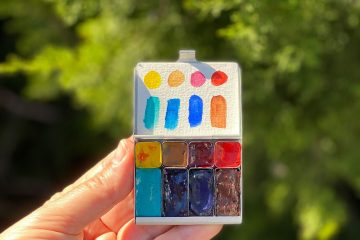Here are four ways to easily add cactus spines while working en plein air:

- White gouache – this is probably my favorite way to add cactus spines. I squeeze out some gouache into a little container with a snap-on lid and keep it in my pack. I prefer Winsor & Newton white gouache as other brands dry up super hard and can’t be reconstituted. I’ve heard where some artists have had problems with it molding, but so far it hasn’t happened to me — but then again it is a pretty dry climate here where I live. I work some paint in the lid of the container and then paint it on with a hard bristled brush such as the Princeton heritage size 2 round or the short handled Cheap Joe’s Golden Fleece rigger pictured here. I wouldn’t go smaller than a size 2 brush, they just don’t seem to hold enough paint. I’ve tortured that golden fleece brush by tossing it in my pencil case and it’s still going strong!
- White Posca paint marker – these are great, unlike the gelly roll pens which always seem to dry up the minute I uncap them lol!
- Pastel pencil – I’ve found both the white and sanguine colors pretty useful! The downside is that then you’d need to carry a pencil sharpener. They’re also great for adding shadows under the spines to reinforce the white and make them pop!
- Watercolors – some spines are darker in color, and something like Venetian red, neutral tint, Payne’s gray, or indigo applied with thick paint works great. You can also use your pocket knife to drag paint out of a wet wash.
Here’s the finished cactus that I did using all of the above techniques:

Let me know if you have any questions!



6 Comments
Mary · April 3, 2022 at 3:09 pm
Regarding a pencil sharpener – while I haven’t done this my dad never carried a pencil sharpener. He sharpened all of his pencils with a knife, especially during travels. I still have pencils he sharpened this way.
Lisa Spangler · April 3, 2022 at 4:42 pm
Hi Mary! That’s a great idea to use a pocket knife! My grandpa used to do the same. Why didn’t I think of that? 🙂
Bob Cochran · April 3, 2022 at 4:14 pm
Thank you for another great post, Lisa. You might find a Kum brand “Meisterwerk” pencil sharpener useful. It is quite small, and is mostly metal with one bit of blue plastic. It sharpens in 2 stages. You cut out most of the pencil lead in the sharpener labelled “1” and then switch to the sharpener labelled “2” to get the point that you prefer. I love it for Tombow Mono 100 pencils. Available at JetPens. The other, larger, mostly plastic Kum sharpeners work acceptably, but they feel more bulky, and to me at least they do not seem to perform as well as the small “Meisterwerk”. I will order some gouache. I need to start working with it. I will see how it holds up in my Maryland climate.
Lisa Spangler · April 3, 2022 at 4:40 pm
Hi Bob! Thanks for the info on the pencil sharpener! The one I have now is also by Kum — it’s called the Wood Cutter — it has 2 holes as well. It works great, I just always forget it back in the car when I go hiking lol! Let me know how the gouache does in Maryland, I’d love to hear.
Bob Cochran · April 3, 2022 at 8:11 pm
I ordered the Winsor & Newton gouache and, in response to your article on cobalt teal blue, the Daniel Smith product — their Cobalt Teal Blue. The order should arrive on Tuesday. I used your Amazon affiliate links.
Lisa Spangler · April 6, 2022 at 10:43 am
Thanks so much for using the links, Bob! Really appreciate it. I’d love to hear how you like the cobalt teal blue and gouache — hope you like them!